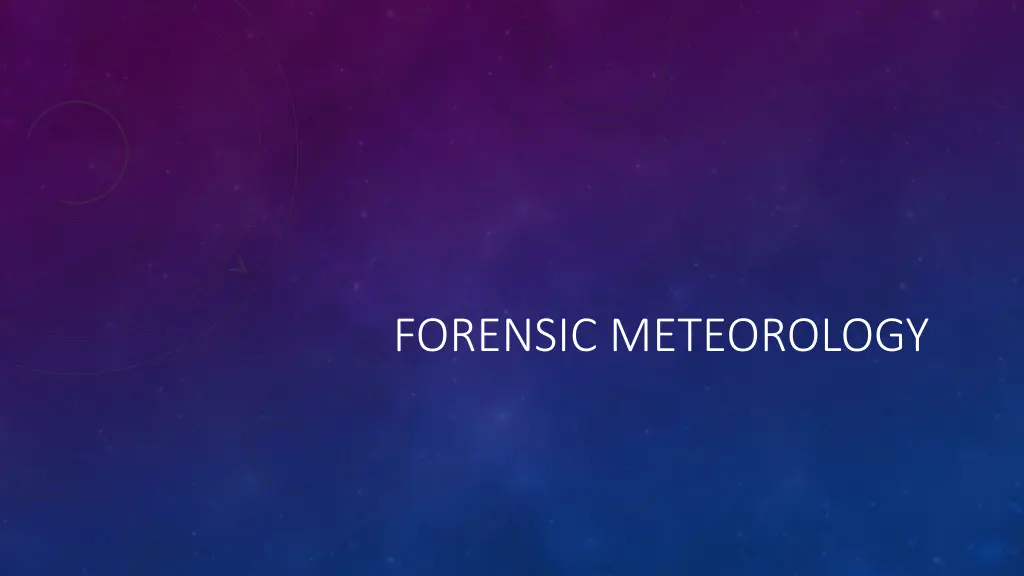
Exploring Forensic Meteorology Cases and Tools
Dive into the world of forensic meteorology, where experts utilize weather data and analyses to investigate civil cases such as personal injury, maritime incidents, construction delays, air pollution, and property damage. Discover the tools of the trade, the tasks forensic meteorologists undertake, and the types of weather-related cases they handle.
Download Presentation

Please find below an Image/Link to download the presentation.
The content on the website is provided AS IS for your information and personal use only. It may not be sold, licensed, or shared on other websites without obtaining consent from the author. If you encounter any issues during the download, it is possible that the publisher has removed the file from their server.
You are allowed to download the files provided on this website for personal or commercial use, subject to the condition that they are used lawfully. All files are the property of their respective owners.
The content on the website is provided AS IS for your information and personal use only. It may not be sold, licensed, or shared on other websites without obtaining consent from the author.
E N D
Presentation Transcript
Forensics: the use of science and technology to investigate and establish facts in criminal or civil courts of law Forensic Meteorology: The study of past weather events as it relates to investigations around insurance fraud claims, civil and criminal trials, and environmental regulatory actions
TOOLS OF THE TRADE FOR FORENSIC METEOROLOGY Weather Maps Weather Observations Radar Images Satellite Images Computer Computer Models
WHAT DO FORENSIC METEOROLOGISTS DO? Gather and interpret data Perform special analysis Prepare written report Evaluate the report or opinion of opposing expert Produce visual aids for presentation Deliver expert testimony
TYPES OF CASES: CIVIL-PERSONAL INJURY PERSONAL INJURY Hourly temp Precipitation times and intensity Snow and ice accumulation Visibility High winds
TYPES OF CASES: CIVIL-MARITIME MARITIME 1. Storms 2. Wind data 3. Wave heights 4. Visibility 5. Precipitation
TYPES OF CASES: CIVIL-CONSTRUCTION DELAYS CONSTRUCTION DELAYS Heavy rainfall Flooding Temperature
TYPES OF CASES: CIVIL-AIR POLLUTION AIR POLLUTION Dispersion models Wind profiles Atmospheric Stability
TYPES OF CASES: CIVIL-PROPERTY DAMAGE PROPERTY DAMAGE Wind data Rainfall records Thunderstorms Hail Lightning
TYPES OF CASES: CIVIL-MVA MVA Precipitation Visibility Fog High winds Sun/moon data Cloud cover
TYPES OF CASES: CIVIL- GENERAL AND COMMERCIAL AVIATION GENERAL AND COMMERCIAL AVIATION Aircraft icing Turbulence Wind shear Thunderstorms Microbursts
EXAMPLES OF CASES- DO NOT WRITE Michael Peterson Murder Trial (2003) Pan Am Flight 103 Trial (2000) OK City Bombing Trial of Timothy McVeigh (1997) OJ Simpson Murder Trial (1995) Clay Shaw Trial for Conspiracy to Assassinate President J F K (1969)
LIABILITY IN SLIP AND FALL CASES- DO NOT WRITE Typically must prove one of the following: A property owner (or their employee) should have recognized a dangerous condition (i.e. a pothole or an uneven walking surface) and removed or repaired the potential danger, but did not. OR A property owner (or their employee) actually caused the dangerous condition leading to the slip and fall accident -- by leaving a hazardous obstacle in a walking path, for example -- and it was reasonably foreseeable that someone would trip and fall due to the condition.
PROVING NEGLIGENCE AND LIABILITY DO NOT WRITE Did the hazardous condition or obstacle exist long enough that a reasonable property owner or employee could have taken action to eliminate the hazard? Did the property owner or employee have a policy of routinely checking for potential hazards on the property, and if so, is there some sort of log or other record of whether the procedure was followed immediately before the accident? Was there a reasonable justification for the creation of the potential hazard? And if so, did this justification still exist at the time of the slip or fall? Could the hazardous condition have been made less dangerous through preventive measures such as relocating the hazard, placing adequate warning signage in the area, or preventing access to the location? Was poor lighting or limited visibility a factor in causing the slip and fall?
PROVING YOU DIDNT CAUSE THE ACCIDENT YOURSELF In order to determine whether a plaintiff might be on the hook for causing any portion of their injuries, here are a few things to think about: Did the plaintiff engage in any activity that might have prevented them from noticing the hazard -- talking or texting on a cell phone, for example -- when an otherwise reasonable person would have noticed it? Did the plaintiff have lawful access to the location where the slip and fall accident occurred, or was there a legitimate reason for the plaintiff to be in a dangerous area? Were adequate warning signs posted, and were other safety measures ignored or not utilized by the plaintiff? If the defense can show that the plaintiff likely caused the accident through his or her own carelessness, winning an injury claim becomes unlikely.
